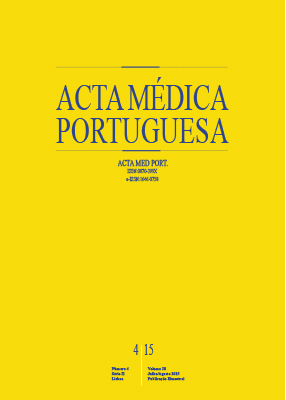Malignant Small Bowel Tumors: Diagnosis, Management and Prognosis
DOI:
https://doi.org/10.20344/amp.6479Keywords:
Capsule Endoscopy, Intestinal Neoplasms, Portugal.Abstract
Purpose: Despite being rare entities, the incidence of malignant small bowel tumors seems to be rising. The development of capsule endoscopy and balloon assisted enteroscopy provided an advance in the assessment of small bowel lesions. We aim to describe the clinical and pathological characteristics of patients with small bowel cancer and ascertain what roles these endoscopic techniques currently have.
Material and Methods: A retrospective study of patients diagnosed with small bowel cancer, from January 2010 to October 2014, was performed. The data was submitted to statistical analysis.
Results: Of the 28 diagnosed patients, 54% were female. The mean age at diagnosis was 61 years. Adenocarcinoma was the most frequent tumor (n = 11), followed by sarcoma (n = 6), lymphoma (n = 6) and neuroendocrine tumors (n = 3). The main form of presentation was related to blood loss or intestinal obstruction. By the time of diagnosis, 46% of patients had distant metastasis/ unresectable cancer. Most of the tumors were diagnosed by endoscopic (41%) or imaging techniques (35%). In the first year after diagnosis, 29% of patients died. In multivariate analysis, adenocarcinoma remained an independent factor for worse survival.
Discussion: Patients with adenocarcinoma presented at late stages and with unresectable tumors, contributing to a worse outcome. A high degree of clinical suspicion for the diagnosis of small bowel cancer is necessary.
Conclusion: The characteristics of the patients were generally consistent with those described in the literature. Capsule endoscopy and balloon assisted enteroscopy are useful in the diagnosis, management and surveillance of small bowel cancer.
Downloads
Downloads
Published
How to Cite
Issue
Section
License
All the articles published in the AMP are open access and comply with the requirements of funding agencies or academic institutions. The AMP is governed by the terms of the Creative Commons ‘Attribution – Non-Commercial Use - (CC-BY-NC)’ license, regarding the use by third parties.
It is the author’s responsibility to obtain approval for the reproduction of figures, tables, etc. from other publications.
Upon acceptance of an article for publication, the authors will be asked to complete the ICMJE “Copyright Liability and Copyright Sharing Statement “(http://www.actamedicaportuguesa.com/info/AMP-NormasPublicacao.pdf) and the “Declaration of Potential Conflicts of Interest” (http:// www.icmje.org/conflicts-of-interest). An e-mail will be sent to the corresponding author to acknowledge receipt of the manuscript.
After publication, the authors are authorised to make their articles available in repositories of their institutions of origin, as long as they always mention where they were published and according to the Creative Commons license.









